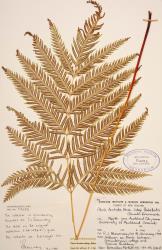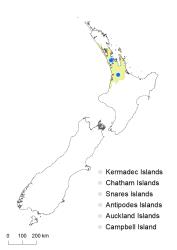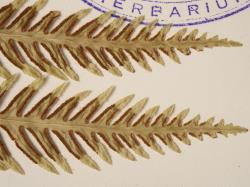Rhizomes erect, scaly. Rhizome scales narrowly ovate, 4–5.5 mm long, 0.5–1.0 mm wide, orange-brown, concolorous, margins ciliate. Fronds 580–1350 mm long. Stipes 230–730 mm long, chestnut-brown proximally, yellow-brown distally, glabrous except for scattered scales proximally. Rachises yellow-brown, not winged, glabrous. Laminae 270–580 mm long, 230–290 mm wide, deeply 1-pinnate-pinnatifid distally, 2-pinnate-pinnatifid proximally, abruptly narrowed to a pinnatifid terminal segment, ovate to elliptic, yellow-green on both surfaces, herbaceous or coriaceous, glabrous. Primary pinnae in 7–11 pairs below pinnatifid apex, slightly overlapping; the longest at or near base, 150–260 mm long, 70–160 mm wide, ovate to broadly ovate, straight or slightly falcate; divided almost to the midrib into secondary pinnae that reduce markedly in length along the length of the pinna; adaxial surface with spine-like growths on the costae; primary pinna apices acuminate, bases stalked; basal primary pinnae with elongated secondary pinnae mainly on the basiscopic side. Longest secondary pinnae 50–125 mm long, 17–50 mm wide, narrowly ovate to linear; apices acute, margins serrate distally, bases adnate to decurrent. Longest tertiary segments 12–35 mm long, 3–7 mm wide, linear. Veins free. Sori continuous along sides of ultimate segments.
Pteris dentata is distinguished by its erect rhizomes, ovate or elliptic glabrous laminae, which are 1‑pinnate‑pinnatifid distally and 2‑pinnate‑pinnatifid proximally. There are 7–11 pairs of pinnae almost divided into secondary pinnae. It is somewhat similar to P. pacifica but has generally longer secondary pinnae that reduce markedly in length from the proximal to the distal end of the primary pinna. It is also similar to P. tremula, but differs in having a less divided lamina that is 1-pinnate-pinnatifid at the mid-point, rather than 2-pinnate-pinnatifid in P. tremula.
North Island: Auckland.
Altitudinal range: 5–60 m.
Recorded from a few places in Auckland city and Hamilton.
Occurs naturally from Arabia to southern Africa and Madagascar, and on St Helena, Ascension and the Cape Verde Islands (Crouch et al. 2011).
An occasional escape from cultivation growing on banks, old brick walls and amongst boulders.
Heenan et al. (1999). Voucher AK 149451, WELT P010253, 1979.
Runemark (1962) recognised two subspecies within P. dentata – subsp. dentata from Ethiopia, Sudan and Yemen to the north of the equator, and subsp. flabellata from Ethiopia to South Africa, mostly south of the equator. However, Roux (2009) reduced both subspecies to synonymy under P. dentata.






